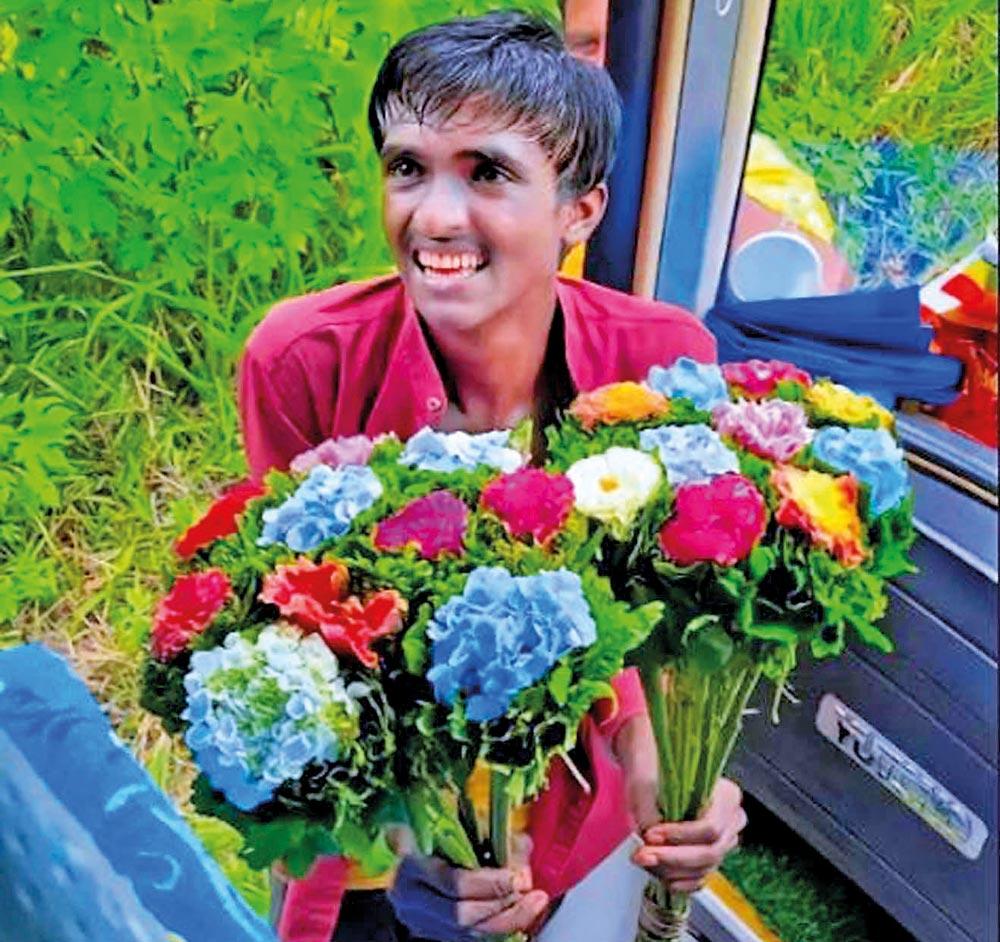Reply To:
Name - Reply Comment

Sri Lankan ‘flower boy’ Dilip Madushanka who was featured in a video taken by a Chinese blogger that went viral on social media

The windy roads that meander through Sri Lanka’s hill country are home to the ‘flower boys’ who gained popularity across social media platforms recently.
It all began when one seller, who goes by the name Dilip Madushanka according to media reports, was featured in a video taken by a Chinese blogger that went viral on social media gathering millions of views.
Their fame wasn’t even partly due to the meticulously bound bouquets they tried to sell to the Chinese tourists, but entirely due to the lengths they went to in order to make a simple sale. And the absolute selling point of it all? The wide-eyed smile they wore through all the heaves and perspiration!
Running after vehicles
Are Sri Lanka’s ‘flower boys’ a phenomenon of the recent decade? Apparently not.
According to Ram, a tour guide from the Ramboda region, the tale of the ‘flower boys’ can be traced back to his school-going days in the 1970s. “There was a waterfall viewpoint along the road passing Ramboda towards Nuwara Eliya. Vehicles carrying tourist used to make a stopover here. During that time, there was an elderly person who was mute. He would visit the viewpoint and carry flowers that he had picked from the surroundings and present it to the foreigners. He didn’t sell them, but distributed them out of love,” said Ram.
He told Daily Mirror that when the elderly person passed away, the young boys and school-goers in the surrounding region continued with the tradition. Eventually, the trend of running after vehicles of locals and foreign tourists emerged.
Ram said that with the emergence of high buildings in the area the viewpoint doesn’t exist now.
“The elderly person was Banda,” Chandika Dissanayake, who has been a tour guide since the early 2000s, shared with Daily Mirror. Banda, who was mute–as Ram stated–had no family and considered a temple in the Polgolla area his home.
“It was Banda who began the tradition of arranging flowers in that fashion. Usually, dahlias, lilies and other flowers that are readily available in the area were used. He also used a particular type of leaf to arrange the bouquet in the way that we see the ‘flower boys’ carrying today,” said Dissanayake.
Dissanayake believes that it all began around the year 2013 as opposed to the 1970s.
Dissanayake further said that the ‘flower boys’ were initially stationed in one place, but eventually found shortcuts through the hills to appear before a vehicle many times.
Different narrative
Udaya Suvendra, an Online Travel Agent, had a different story to relate. According to him, the origin of the ‘flower boys’ can be traced back to the mid-1970s. They are the products of tourist drivers.
“Guests are usually exhausted during the journey uphill and after the stopovers at waterfalls and tea plantations. They usually parked their vehicles and encouraged the tourists to enjoy the view. During these stops, there were boys carrying flowers trying to make a sale. So the drivers used to ask them to follow these tourists to the top of the hill and surprise them. And they strategised it in such a manner that the guests were actually baffled as to how the same person could appear in multiple bends. When the ‘flower boy’ reached the top of the hill, the drivers gave them a tip. The guests too, moved by the efforts of the boys, would give them a tip or purchase the flowers. So this was actually developed by tourist drivers. This attraction has developed to the point where some tourists request to see the flower boys,” said Suvendra.
Speaking further, he also attributed the popularity of the Nine Arch Bridge to tourist drivers. “During those times, the drivers who took tourists to Adam’s Peak didn’t have accommodation. While the guests could obtain accommodation at plantation bungalows, there were no quarters available for drivers; they had to sleep in their vehicles. So, the drivers resolved to promote Little Adam’s Peak in Ella, instead of Adam’s Peak, as they could get accommodation in Ella. During this time, the drivers used to also promote the Nine Arch Bridge to the tourists. And that is how it became a popular tourist point and thereby made it to Sri Lanka’s tourism billboards,” he said.
He said, “It is most often the tourist drivers who find attractions at the grassroots and promote them among tourists.The influencers that the Sri Lanka Tourism Promotion Bureau (SLTPB) brought down could not achieve what the ‘flower boys’ managed to achieve. The SLTPB is not aware of the happenings at the grassroots level,” opined Suvendra.
|
|
Should the ‘boys’ be promoted?
While the ‘flower boys’ are no doubt an interesting concept and have certainly garnered the attention of locals and tourists alike, is it something that can or should be promoted in Sri Lanka?
“This is what Sri Lanka tourism needs today,” opined Srilal Miththapala, Tourism Consultant for the Asian Development Bank and Past President of The Hotels Association of Sri Lanka.
Speaking to Daily Mirror, he emphasised that the ‘flower boys’ are a unique phenomenon that should be marketed by the tourism industry. “We must look for unique, out-of-the-box offerings; not go down the familiar cow path of normal promotions. We do the same thing–village walks, bicycle tours, etc. which are old. A different narrative is required to promote Sri Lanka tourism; and in that context, this is a very interesting phenomenon that should be packaged well and promoted with a story woven around it. Ninety percent of the time, people buy these flowers because of their persistence and because they feel sorry for them,” said Miththapala.
He said that the boys with bouquets simply running down and through hills wouldn’t achieve the desired target, but promoting it with its history, their agility, including how the boys manage to earn, and the support they get from their communities should be put together into a story.
“Is there a country that doesn’t have good hotels, good food, air conditioners and wifi? Tourists are looking for that little extra feature and the authentic experience. That is something Sri Lanka can offer,” Miththapala added.
Daily Mirror also reached out to Nalin Perera, Director General of SLTDA, to see what potential this institute saw promoting and marketing Sri Lanka’s ‘flower boys’. Perera said that it isn’t a product that one can sell, but, it spreads the message of hospitality.
Whether it was Banda who first helped the ‘flower boys’ flourish, or the tourist drivers who played a role to promote them, the ‘flower boys’ embody a story of determination. They demonstrate how the local youth are enhancing the tourist experience in Sri Lanka in their own unique and remarkable way.